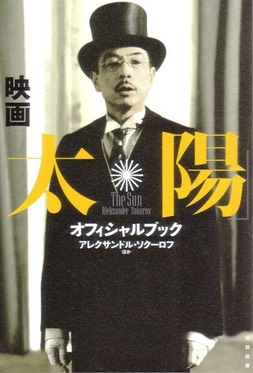
A year and a half ago, on the occasion of the Nichigei Film Festival which as focused on the representation of the Japanese emperor in film (see my writeup here), I talked a bit on this blog about the difficulty of representing the Japanese emperor on film. This did not mean the emperor was never represented, but even a 1957 feature film like The Solitary One, which I discussed in the writeup, only showed the Crown Prince (later the Heisei Emperor) metonymically though his voice or hands. The emperor became a cinematic problem, posing questions as to how the gaze at the emperor (by characters, by the camera) can be constructed, and, in some cases, how the emperor himself can gaze. Can the emperor, for instance, be made the subject of a point of view shot, which essentially inserts the spectator’s gaze in his, and if so, how?
I had the opportunity to consider this when Alexander Sokurov made the film The Sun (Solntse, 2005) about Hirohito in the last days of WWII, with Issey Ogata playing the emperor. The right wing made threats against the film, but it ended up screening successfully in Japan. An “official book” was produced, and I was asked to contribute an essay. I introduced one of our Yale students at the time, Jeremi Szaniawski, who also contributed a piece (he later published his dissertation on Sokurov as The Cinema of Alexander Sokurov). Since the volume was in Japanese, I tried to save myself some time by writing the article in English and having another Yale student, Naoki Yamamoto, translate it. (It’s unfortunately another one of my Japanese articles I never got around to publishing in English, a few of which I have begun uploading on to the Yale repository, with English versions when available, such as my 1994 article on Suzuki Seijun’s firing from Nikkatsu and my best 30 Japanese films of 1989–1997.)
Here’s an abstract for my contribution, entitled in English "Between The Sun and Japan: An Inter-national Ethics of Cinema”:
This article considers how Alexandr Sokurov’s film The Sun (Solntse, 2005) approaches the problem of representing the nation by foregrounding the issue of the ethics of representing a foreign country—in this case, the Shōwa emperor Hirohito. This becomes a cinematic problem because of the way the Japanese emperor, in films ranging from The Last Samurai to The Emperor, the Empress, and the Sino-Japanese War, has often been treated as an object or subject of the gaze. Focusing on the mismatched gazes in the film, this article finds the spectator floating between the two gazes or between the seer and the seen, and ultimately between light and dark, sun and moon, inside and outside, human and animal, human and divine, actor and character, and even America and Japan. Sokurov is interested in the Shōwa emperor less because of the “Japan” he represents, than because he allows the director both to explore the unique artistic gaze of cinema, as well as to proffer a certain morality of representation, where the national can only be shown through the inter-national—through the gaps between nations. The Sun is thus the embodiment of a complex dialectics between nation and nation, filmmaker and viewer, film and culture.
I recently uploaded the original English as well as the published Japanese version onto the Yale repository. You can read it here.
Here is the bibliographic information for the original publication:
- "Taiyō to Nihon no aida: Eiga ni okeru intanashonaruna rinri” (Between The Sun and Japan: An Inter-national Ethics of Cinema). Eiga Taiyō ofisharu bukku (Official Book of the Film The Sun). Eds. Aleksander Sokurov, et al. Tokyo: Ōta Shuppan, 2006. Pp. 148-157.

